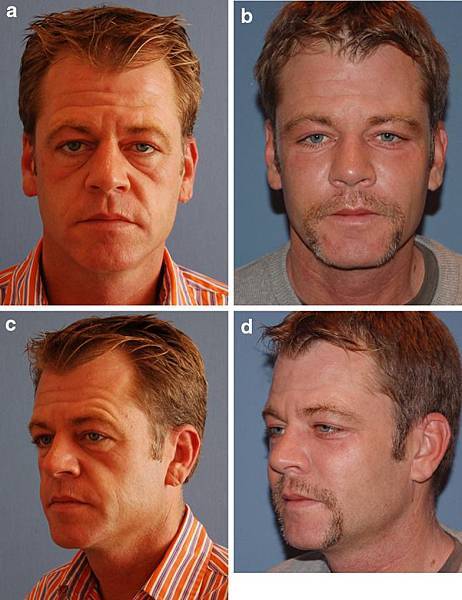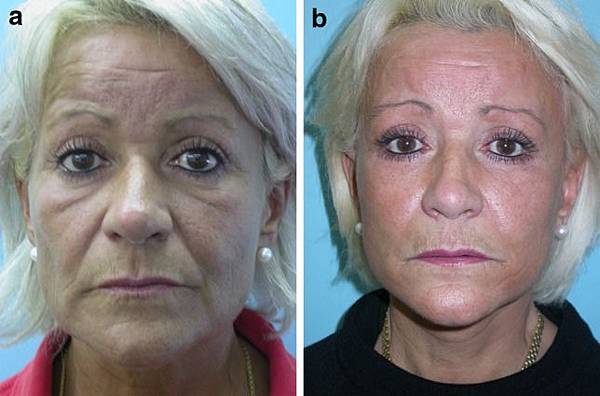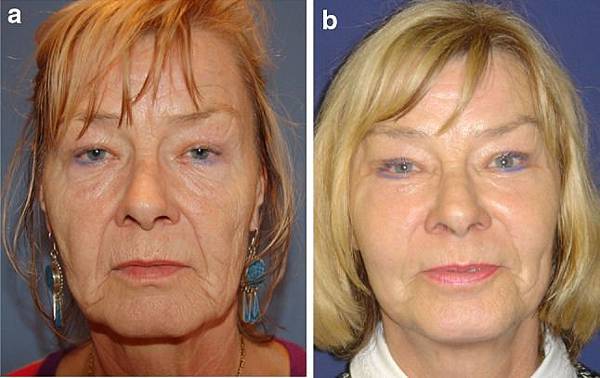Vertical Subperiosteal Mid-face-lift for Treatment of Malar Festoons(5)
Results
The median observation time was 12 months. The procedure on average took 2 h 40 min ± 25 min. Immediate healing was achieved without major complications, adverse reactions, or side effects. Edema remained for 10–12 days.
No alopecia was observed; no swelling or seromatous fluid collection necessitated a second procedure or prolonged drainage. Three patients showed a very small intraoral wound dehiscence of 3-5 mm, two on the left side and one on the right side. Using daily local irrigation, the wound healed by secondary intention after 7 days. All patients were judged to have satisfactory cheek elevation and enhanced contour without evidence of recurrent festoons, ptosis, or loss of fixation. The patients did not complain of pain in the treated area 3 days after surgery. They did not take painkillers for more than 2 days after surgery.
The surgical outcome was evaluated by analyzing photographs taken before and after surgery, and by analyzing pre- and postoperative measurements. Despite that 6 months after surgery drooping of the lateral brow position was observed at a mean of 2.3 mm, the technique we used achieved a significant rejuvenation of the midface and the malar festoons (Table 1). The examples seen in Figs. 13, ,14,14, ,15,15, ,16,16, and and1717 illustrate the indications and results.
Table 1
Pre- and postoperative evaluation of the position of the nasojugal groove after a vertical upper-midface lift (SUM-lift) (N = 12)
Preoperative 6-month postoperative 12-month postoperative
AB (cm) 5.8 ± 0.4 6.3 ± 0.3 6.0 ± 0.3
AB distance between the oral commissure and the nasojugal groove position
Pre- and postoperative evaluation of the position of the nasojugal groove after a vertical upper-midface lift (SUM-lift) (N = 12)

Fig. 13
a, c Preoperative views of a 54-year-old patient with ptosis of the malar tissues, hollowing of the infraorbital area and the cheek area, lengthening of the lower eyelid, attendant tear-trough deformity, and associated nasojugal grooves, nasolabial folds, ...

Fig. 14
a, c Preoperative views of a 48-year-old patient. He demonstrates ptosis of the malar tissues, loose festoons, hollowing of the infraorbital area, lengthening of the lower eyelid, attendant tear-trough deformity, and nasojugal grooves. b, d Six months ...

Fig. 15
a Preoperative view of a 56-year-old patient with marked loose festoons and deep nasojugal grooves. b Postoperative view 12 months after vertical upper-midface lift (SUM-lift) procedure. Note the improvement of the malar bags

Fig. 16
a Preoperative frontal view of a 58-year-old woman. She has marked malar festoons with ptosis of the malar tissues, hollowing of the infraorbital area and the cheek area, lengthening of the lower eyelid, attendant tear-trough deformity, and nasolabial ...



 留言列表
留言列表
